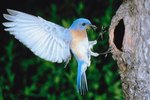Things You'll Need
6 wood boards, 1/2 inch by 3 inches by 8 inches
Scroll saw drill
1 dowel peg, 1/2 inch by 2 1/2 inches
Wood glue
Ruler
12 dowel pegs, 1/4 inch by 1/2 inch
Corner clamps
2 wood boards, 1/2 inch by 9 inches by 9 inches
Pencil
Hammer
Nails
Hinge
Screws
Door clasp
Birdhouses make lovely additions to a garden or porch. They allow us a sneak peak into the lives of the birds that frequent our yards. While birdhouses can be made of almost any material, a naturally rot-resistant and hardy wood such as cedar or redwood is perhaps the most popular choice. Other common woods require varnishing or painting to protect them from the elements. Building a hexagonal birdhouse is an interesting twist on the typical four-sided birdhouse. It is something you won’t readily find available on the market.
Miter the long edges of the six smaller boards inward at a 60-degree angle. Cut a 2-inch by 2-inch square in the center of one board for the door.
Drill a 1/2-inch hole, about 3/4 inch below the door. Glue the end of the 2 1/2-inch dowel and squeeze it into small hole. Let it dry.
Drill two 1/4-inch diameter holes into the mitered edges of the boards, 2 inches from the end of each of the six boards. The holes in each board must line up with one another, so measure carefully. Drill the holes 1/4-inch deep, at a 90-degree angle to the mitered edge of the board--this way, the small dowel pieces will sit evenly between the holes in the boards, keeping them together.
Dry fit the hexagonal house together, putting a dowel peg in each hole, then pressing the sides together—the mitered edges will match up to form the corners. Once you are happy with the fit, run a line of glue along each joint and into the dowel holes. Reassemble the hexagon and clamp tightly with the corner clamps and let dry.
Place the hexagonal box on top of one of the larger boards. Trace around the edges onto the board. Repeat with the second board.
Cut out the traced hexagonal pieces.
Place one of the hexagonal boards over the top of the hexagonal box, matching up the sides. Nail the board down with three nails in each side. Invert the box, so the remaining open end is on top.
Screw the hinge onto one of the six sides of the remaining hexagonal board. Position the board on top of the birdhouse, aligning the sides. Screw the remaining portion of the hinge onto the back of the birdhouse so the lid can be lifted.
Position the door clasp on the front of the birdhouse, opposite the hinges. Screw down the door clasp with one part on the lid and the corresponding part on the box.
Drill small holes at the top and bottom of each side of the hexagon for ventilation and drainage.
Tips
Use the hinged lid to make cleaning out the birdhouse easier.
Attach the birdhouse by either bolting it through one side to a tree or under the eaves of your house, or drilling two holes into the back side and wiring it in position through the holes.
References
Photo Credits
-
birdhouse image by Wouter Tolenaars from Fotolia.com
Writer Bio
B.T. Alo is media director, chief writer and editor for a U.S.-based marketing and consulting firm. He holds a bachelor's degree in business and communications. Alo's interests include business, investments, electronics, personal finance, health, communication, popular trends and travel.




